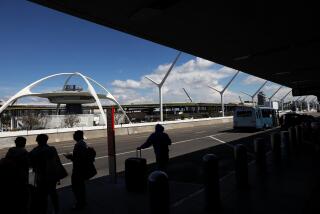New Tool for Perilous Runways
WASHINGTON — An aviation safety technology being tested in the United States soon could help prevent accidents like last week’s crash of a Los Angeles-bound Boeing 747 on a Taipei runway that was closed for construction.
The technology, analogous to navigation aids now available for use in automobiles, would place a small screen in the cockpit that uses information from a satellite to display an aircraft’s location on a moving map of airport taxiways and runways.
“The bottom line is, if Hertz can put this stuff in my rental car, we should darn well have it in the cockpits of aircraft,” said Steve Alterman, president of the Cargo Airline Assn., an industry group.
Even in fog or on a rainy night, pilots would be able to know precisely where they were at the airport and whether they were turning onto the correct runway. The system could be designed so that a runway that has been closed for construction would light up in red on the display. The location of nearby planes and vehicles also could be shown.
Runway Safety Concerns
Runway collisions are considered the leading hazard in commercial aviation. Arnold I. Barnett, a widely recognized aviation consultant at MIT, has projected 15 fatal runway collisions at U.S. airports within the next 20 years if nothing is done. Nearly every day, the Federal Aviation Administration records a new runway safety incident, with 80% of them involving planes that come too close to other planes.
The safety technology is being developed by several companies, including UPS Aviation Technologies, Rockwell Collins and Honeywell Inc. Known as ADS-B, it relies on Global Positioning System satellites instead of radar. Aircraft equipped with ADS-B receive the exact position of nearby planes or vehicles also equipped with the technology. It can be used in flight or on the ground.
The FAA, which is testing ADS-B, hopes it will not only improve runway safety but decrease air traffic congestion by allowing more flexibility in routing airborne planes.
“You get a major safety improvement along with the efficiency,” said Dave Ford, an agency official responsible for advanced technologies. “Our hope is that more and more people will see the benefits of this technology.”
The FAA has no current plans to require installation of the equipment, however.
FAA Tests Technology
UPS, which operates 235 cargo aircraft, plans to install ADS-B throughout its fleet by the end of 2002.
The week before the Singapore Airlines disaster, the moving map technology underwent a major FAA-sponsored test in Louisville, Ky. Pilots with and without the navigation aid were given a set of complicated taxiing instructions. The pilots of aircraft equipped with the cockpit displays completed the tests successfully. Some of the pilots who did not have the technology got lost. The tests were done in broad daylight.
In the crash of Singapore Airlines Flight 006, which killed 81 of the 179 people on board, investigators say Capt. C.K. Foong mistakenly turned onto Runway 05R. He was supposed to be on a parallel runway, 05L. Foong was aware that 05R was closed for construction and air traffic control transcripts indicate that he believed he was on 05L.
Runway entrances are marked with illuminated signs that identify the runway. But the weather was bad on the night of the crash, and it is unclear what the Singapore Airlines crew saw from their cockpit windows.
In an FAA study of 40 U.S. runway safety incidents that occurred in 1997 and were judged to have “extremely high accident potential,” every one took place under reduced visibility conditions.
Ken Shapero, a spokesman for UPS Aviation Technologies, said the system is ideal for use in such circumstances. “When a pilot’s ability to determine his or her position on the airport is reduced, that’s when you need an aid in the cockpit,” Shapero said. “Today, the only aid we have in the cockpit is a paper map.”
Accidents involving commercial airliners that stray onto runways under construction are extremely rare, but they have happened. An infamous one in Mexico City involved a flight that had taken off from Los Angeles.
On Oct. 31, 1979--exactly 21 years before the crash of Flight 006--the Western Air Lines “Night Owl” flight from Los Angeles International descended through a fog bank to a planned early morning landing at Benito Juarez International Airport.
Flight 2605 was cleared to land on Runway 23R, but the pilot instead lined up with Runway 23L, which was closed for construction. The DC-10 jet collided with a parked truck and other equipment before breaking up in a fiery wreck that killed 72 of the 88 people on board.
*
* TAIPEI CRASH INQUIRY
Probe focuses on whether the lights of closed runway were on. A9
More to Read
Inside the business of entertainment
The Wide Shot brings you news, analysis and insights on everything from streaming wars to production — and what it all means for the future.
You may occasionally receive promotional content from the Los Angeles Times.









